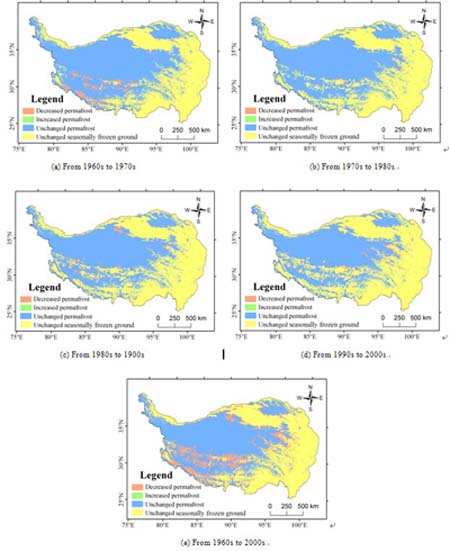Decadal Permafrost Distribution and Degradation Tendency on the Qinghai-Tibet Plateau, China
The distribution of permafrost is an important climatic and environmental indicator, and rising global air temperatures are expected to intensify permafrost degradation. In China, high-altitude permafrost on the Qinghai-Tibet Plateau (QTP) is highly sensitive to climate warming, and its degradation is likely to cause many problems relating to engineering, water resource preservation and environmental protection. Thus, understanding the change in permafrost distribution on the QTP has both scientific and economic significance.
To simulate and dynamically monitor changes in permafrost distribution on the QTP during a long time series, Associate Professor CHENG Weiming, Institute of Geographic Sciences and Resources Research, Chinese Academy of Sciences (IGSNRR, CAS), and his research fellows address the response model that uses data from digital geomorphology, mean annual air temperature (MAAT) and the vertical lapse rate of temperature. Compared with published maps of permafrost distribution, the accuracy of the simulated results is about 85 per cent.
The simulated areas of permafrost were 1.60×106km2, 1.49×106km2, 1.45×106km2, 1.36×106km2 and 1.27×106km2, respectively, in the 1960s, 1970s, 1980s, 1990s and 2000s. The rate of permafrost loss has accelerated since the 1980s, and the total area of degraded permafrost is about 3.3×105 km2, which accounts for about one-fifth of the total area of permafrost in the 1960s, and degraded permafrost regions are mainly distributed in the boundary regions between permafrost and seasonally frozen ground.
The related results have been published in the journal of Permafrost and Periglacial Processes (IF=2.516) (Cheng Weiming,Zhao Shangmin,Zhou Chenghu, Chen Xi, 2012, Simulation of the Decadal Permafrost Distribution on the Qinghai-Tibet Plateau (China) over the Past 50 Years, Permafrost and Periglacial Process, 23: 292-300, DOI: 10.1002/ppp.1758).
 |
| Spatial distribution change of the permafrost on the QTP over past 50 years. Where (a) “Decreased permafrost”, permafrost in 1960s but degraded to seasonally frozen ground in 1970s; “Increased permafrost”, seasonally frozen ground in 1960s but transformed to permafrost in 1970s; “Unchanged permafrost”, permafrost both in 1960s and 1970s; “Unchanged seasonally frozen ground”, non-permafrost both in 1960s and 1970s. The meanings of the legends in (b), (c), (d) and (e) can reference to them in (a).(Imaged by CHENG Weiming) |
Download attachments: